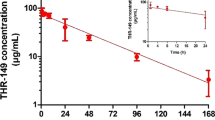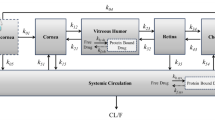Abstract
Purpose. To develop a pharmacokinetic/pharmacodynamic (PK/PD) model for an α1-blocker (bunazosin) after instillation. The PK/PD model can predict both the drug concentrations in various ocular tissues and the hypotensive effect.
Methods. Bunazosin concentrations were determined with High Performance Liquid Chromatography (HPLC) in tear fluid, the aqueous humor, cornea, and iris-ciliary body after instillation or ocular injection into the anterior chamber in rabbits. After instillation of bunazosin in rabbits, intraocular pressure (IOP) was also determined with a pneumatic tonometer. The PK/PD parameters were estimated by fitting the concentration-time profiles and the hypotensive effect-time profiles to the developed PK/PD models using the MULTI (RUNGE) program.
Results. On the basis of the concentration-time profiles of bunazosin, a PK model, including seven compartments, was developed for examining the behavior of bunazosin after instillation. Then, two PK/PD models for hypotensive effect of bunazosin were developed using an indirect response (model A) and the relationship between IOP and aqueous humor flow (model B). These models well described the concentration-time profiles and hypotensive effect-time profiles of bunazosin after instillation.
Conclusions. This study is the first trial to develop a PK/PD model for an antiglaucoma agent using an indirect response and the relationship between IOP and aqueous humor flow.
Similar content being viewed by others
references
H. Sasaki, K. Yamamura, T. Mukai, K. Nishida, J. Nakamura, M. Nakashima, and M. Ichikawa. Enhancement of ocular drug penetration. Crit. Rev. Ther. Drug Carrier Syst. 16:85-146 (1999).
K. Yamamura, H. Sasaki, M. Nakashima, M. Ichikawa, T. Mukai, and K. Nishida. and J. Nakamura. Characterization of ocular pharmacokinetics of beta-blockers using a diffusion model after instillation. Pharm. Res. 16:1596-1601 (1999).
K. Yamaoka, Y. Tanigawara, T. Nakagawa, and T. Uno. A pharmacokinetic analysis program (MULTI) for microcomputer. J. Pharmacobiodyn. 4:879-885 (1981).
M. Sakurai, M. Araie, T. Oshika, M. Mori, N. Shoji, and K. Masuda. Effects of topical application of UF-021, a novel prostaglandin-related compound, on aqueous humor dynamics in rabbit. Jpn. J. Ophthalmol. 37:252-258 (1993).
K. Yamaoka and T. Nakagawa. A nonlinear least squares program based on differential equations, MULTI (RUNGE), for microcomputers. J. Pharmacobiodyn. 6:595-606 (1983).
T. Takagi, N. Sun, Y. Kuwayama, R. Yamamoto, M. Tanaka, T. Kusunoki, Y. Shimizu, and R. Manabe. The effect of bunazosin hydrochloride on intraocular pressure and aqueous humor dynamics in human. Acta Soc. Ophthalmol. Jpn. 95:273-278 (1991).
G. L. Zhan, C. B. Toris, C. B. Camras, Y. L. Wang, and M. E. Yablonski. Bunazosin reduces intraocular pressure in rabbits by increasing uveoscleral outflow. J. Ocul. Pharmacol. Ther. 14:217-228 (1998).
N. L. Dayneka, V. Garg, and W. J. Jusko. Comparison of four basic models of indirect pharmacodynamic responses. J. Pharmacokinet. Biopharm. 21:457-478 (1993).
J. M. Conrad and J. R. Robinson. Aqueous chamber drug distribution volume measurement in rabbits. J. Pharm. Sci. 66:219-224 (1977).
S. F. Nilsson. The uveoscleral outflow routes. Eye 11:149-154 (1997).
K. Nishimura, E. Shirasawa, M. Kinoshita, M. Hikida, and Y. Kuwayama. Ocular hypotensive effects of topically applied bunazosin, an α1-adrenoceptor blocker, in rabbits and cats. Acta Soc. Ophthalmol. Jpn. 95:746-751 (1991).
M. C. Makoid and J. R. Robinson. Pharmacokinetics of topically applied pilocarpine in the albino rabbit eye. J. Pharm. Sci. 68:435-443 (1979).
R. D. Schoenwald. Ocular drug delivery. Pharmacokinetic considerations. Clin. Pharmacokinet. 18:255-269 (1990).
A. Kato and S. Iwata. Corneal permeability to bunazosin in rabbits. J. Pharmacobiodyn. 11:181-185 (1988).
H. Derendorf and B. Meibohm. Modeling of pharmacokinetic/pharmacodynamic (PK/PD) relationships: concepts and perspectives. Pharm. Res. 16:176-185 (1999).
Y. Kimoto, M. Nozaki, and T. Itoh. Actions of the alpha-1 adrenoceptor blocker bunazosin on the norepinephrine-induced contraction of smooth muscles in the rabbit proximal urethra. J. Pharmacol. Exp. Ther. 241:1017-1022 (1987).
Y. Yamada, K. Matsuyama, K. Ito, Y. Sawada, and T. Iga. Risk assessment of adverse pulmonary effects induced by adrenaline beta-receptor antagonists and rational drug dosage regimen based on receptor occupancy. J. Pharmacokinet. Biopharm. 23:463-478 (1995).
Author information
Authors and Affiliations
Corresponding author
Rights and permissions
About this article
Cite this article
Sakanaka, K., Kawazu, K., Tomonari, M. et al. Ocular Pharmacokinetic/Pharmacodynamic Modeling for Bunazosin After Instillation into Rabbits. Pharm Res 21, 770–776 (2004). https://doi.org/10.1023/B:PHAM.0000026426.20012.36
Issue Date:
DOI: https://doi.org/10.1023/B:PHAM.0000026426.20012.36




